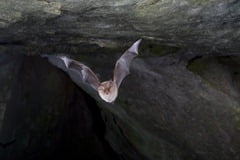
New evidence from the UK has proved that tiny bats can and do cross the sea from Britain to mainland Europe. A thumb-sized Nathusius pipistrelle originally ringed in the UK has been recovered dead almost 600km away by bat researchers in the Netherlands.
Because these tiny bats, which weigh just 6-15 grammes, are too small to carry satellite tracking tags often fitted to birds researchers have been left largely in the dark about their migratory movements. On the continent some migration routes are well known, and studies have shown that pipistrelles can travel great distances over land.
The fact that bats have been recorded on oil rigs in the North Sea has long suggested that they can also migrate across large bodies of water, but this is thought to be the first piece of concrete evidence that a Nathusius pipistrelle has successfully made the crossing.
The bat was originally ringed on the 14 October 2012 at Blagdon lake near Bristol by Daniel Hargreaves of the Bat Conservation Trust. It was a male Nathusius’ pipistrelle that weighed just 7.6 grammes and was found 596 kilometres from where it was ringed.
“We have only ringed 34 bats at Blagdon lake so to receive a record like this is astonishing,” said Mr Hargreaves. “It’s incredible to think that this little bat has flown a distance of at least 600km, avoiding hazards like roads and wind turbines, and for it to safely cross the sea is remarkable.”
Dr Fiona Mathews at the University of Exeter stresses that Nathusius pipistrelle is one of the European bat species most at risk from wind turbine developments.
“Nathusius’ pipistrelle is one of the species most at risk from land-based wind turbines throughout Europe,” said Dr Mathews. “We now urgently need to identify the migration routes they use to cross the sea between the UK and continental Europe: offshore wind farms in the wrong place could be very bad news. In the autumn, we installed bat detectors on board Britany Ferries crossing to and from South-West England. We are analysing the data to find out when and where bats are recorded at sea and clearly now need to extend these surveys to include The North Sea.”
The first confirmed breeding colony of Nathusius pipistrelle on the island of Ireland was found near Lough Neagh in May 1997. According to Bat Conservation Ireland the species is found around the northern and eastern edges of the lake and in Co. Down. It has also been recorded by bat detector in several counties in the Republic of Ireland, but with no confirmed breeding as yet. We don’t currently know whether Irish Nathusius pipistrelles migrate within Ireland, or from Ireland to other countries to overwinter.
Photo Credit: Daniel Hargreaves / Bat Conservation Trust









